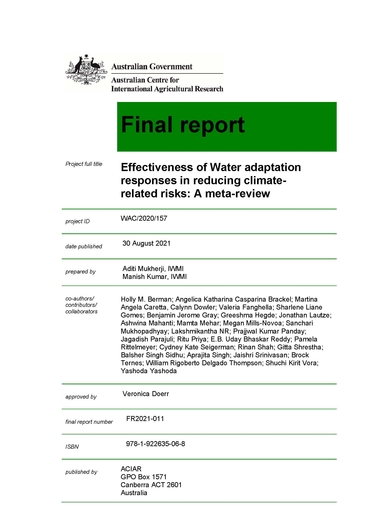Effectiveness of water adaptation responses in reducing climate-related risks: a meta-review. Final report
Abstract
Anthropogenic climate change impacts every aspect of water security through changes in water availability and quality, increases in water-induced disasters, and changes in ecosystems and their services. In response to climate and non-climate induced water insecurity, people and governments around the world are undertaking various adaptation responses. While there are thousands of case studies of current implemented adaptation responses to water insecurity, there is a lack of synthesized understanding about the effectiveness of these responses in reducing risks. In this report, we describe our meta-review methodology for assessing the outcomes of current water-related responses. For assessing the outcomes of current adaptation responses, we use a database of 1819 documented case studies of adaptation across all sectors published since 2014. Of these, only 359 (19.7%) case studies assess the effectiveness of current water-related adaptation responses. Outcomes are measured across 6 dimensions and an adaptation response is deemed to be “beneficial” in reducing climate or related risks if the study documents a positive outcome on any of these six “outcome” indicators. These are: (1) the response led to positive economic/financial outcomes; (2) positive water-related outcomes; (3) positive environmental/ecological outcomes; (4) positive outcomes for vulnerable populations; (5) positive institutional or sociocultural outcomes; and (6) positive outcome on any other parameter not captured by the above five indicators. Using these criteria, 319 out of 359 (88.9%) studies that documented waterrelated adaptation were deemed to be “effective” in reducing risks. However, only 64 (17.8%) of those studies were of “high” enough quality to causally link adaptation response with the outcome, while the rest failed to do so, making the evidence base even smaller. Overall, only 64 out of 1819 studies (3.5%) of all studies provide an assessment of the benefitsof adaptation response with a high degree of rigour. A majority (~81%) of the adaptation responses were about adaptation in the agriculture sector, followed by adaptations in water-related disasters sector, and urban and peri-urban water use. About one-third, of the adaptation responses which were found to be “effective”, were also deemed to be maladaptive, especially if it involved intensification that needed fertilizers and pesticides or water-intensive crop varieties. The majority of the water adaptation responses are about incremental adaptation, that is adaptation that aims to improve existing ways of doing things (e.g., better crop varieties replacing older varieties), without tackling root causes of vulnerability. Cases on transformative adaptation are few and far between, and migration, and capacity building and training seem to be the only two adaptation responses that have transformative possibilities. Similarly, a large number of case studies documented limits or barriers to adaptation, and the main barriers were deemed to be financial, or governance-related, followed by lack of information and awareness, and capacity. Given the huge database, and that it took almost 5 out of 6 months of the project to get all the articles coded and quality checked. Thus, the analysis in this report is preliminary and limited to summary statistics.

